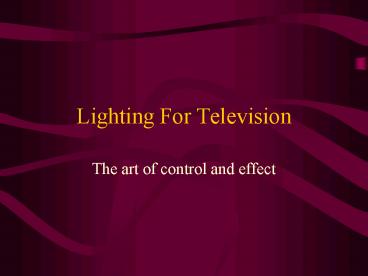Lighting For Television PowerPoint PPT Presentation
1 / 9
Title: Lighting For Television
1
Lighting For Television
- The art of control and effect
2
The Principles of Light
- Light is part of the electromagnetic energy
spectrum.
X-ray and Gamma rays
Violet Indigo Blue Green Yellow Orange Red
The Electromagnetic Spectrum
Radio and Communications freq.
Audio 20 Hz 20 KHz
3
Lighting Terminology
- Color Temperature The relative reddishness or
bluishness of light. Measured in degrees Kelvin. - Primary Colors For light the primary colors are
Red, Blue, Green - Photographic principle Lighting design utilizing
3 lights to light a subject. - Gel A colored filter that allows only certain
light to pass through the filter. - Fresnel A hard light that is a common type of
light fixture for a TV Studio.
4
Lighting Terminology (cont.)
- Hard light A directional light sources that
produces sharp falloff (shadows have edges) - Soft light Diffused light that produces few
shadows. - EFP Floodlight Used for portable lighting
situations. Usually consists of a bright halogen
bulb Very hot to touch. - Ellipsoidal Spotlight An adjustable lighting
fixture that allows the lighting director to
focus light where he/she would want it.
5
Lighting Terminology (cont.)
- Flag Cloth or material that will block light
from an area of a set. - Scoop A light fixture that has no lens and
produces soft light. - Kelvin Scale the scale used to measure the
relative reddishness or bluishness of light. - Light Plot A detailed diagram that shows the
placement of lights on the light grid. - Grid A support system that lights are hung from
6
Lighting Terminology (cont.)
- Raceway The electrical grid that supplies
electricity to the grid. Usually it is a complex
array of wires. - Light board A control panel that allows an
operator to control light intensity to each
circuit. - Gaffer An assistant lighting director.
- Falloff The intensity of the shadows edge
produced by a light fixture
7
The Photographic Principle
- Most common type of lighting design
- Or 3 point lighting
- Key light
- Back light
- Fill light
Fill Light Soft light
Back Light (hard or spot light)
Key Light (hard or spot light)
8
The Kelvin Scale
- Measures the relative Reddishness or bluishness
of light
Kelvin Scale
20,000 K 15,000 K 5600 K 3200 K 2800 K 2200
K 1200 K
Outdoor light on a stormy day
Outdoor light on a cloudy Day
Outdoor light on a beautiful sunny day (Approx)
Studio lighting (Quartz/Halogen light fixtures)
Fluorescent lighting fixture
Incandescent Light fixture
Candle light
9
Light Plot Plan

